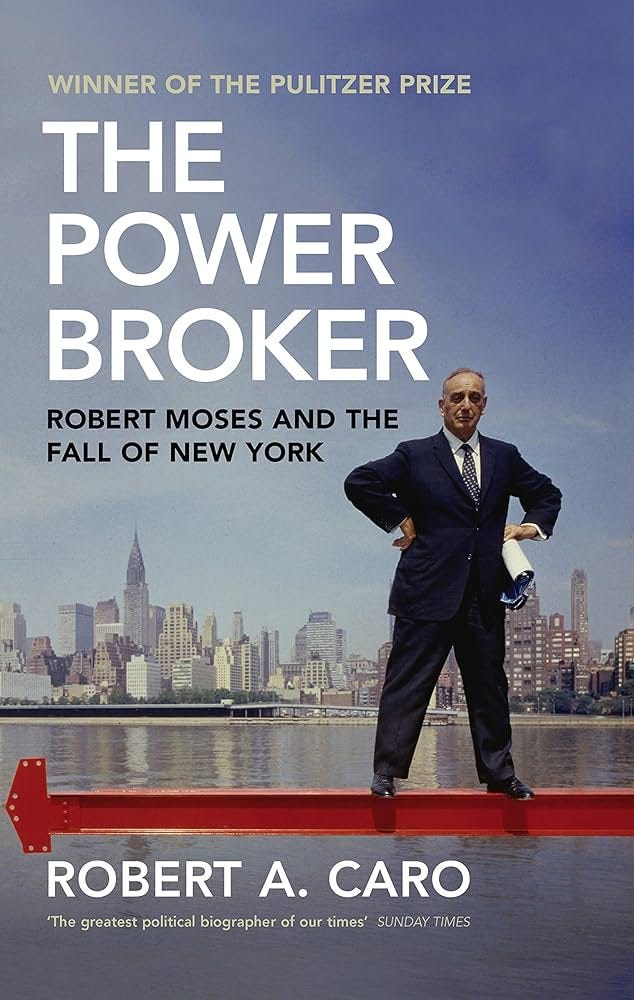Two thoughts on the first 300 pages of The Power Broker
A 50 year old book is rocking my world
I can’t remember the moment I was turned on to Robert Caro. I’ve been aware of The Power Broker for years, but it wasn’t until I watched the documentary Turn Every Page: The Adventures of Robert Caro and Robert Gottlieb that I became a super fan.
Seeing his writing process and his research process filled me with the deepest respect. His books take years to write. He’s published six in 50 years. Today I want to talk about the first 300 pages of his first book, The Power Broker: Robert Moses and the Fall of New York.1
What I’ve discovered in these 300 pages is that Caro is a master storyteller who structured his book with style. Allow me to explain.
The stories are memorable
Robert Moses started coming to power in New York City in the 1920s and he gained his power via control of the Parks Commission. He built parks, expressways, parkways, beaches, and other significant public works. Caro tells one engaging story after another about Moses’ machinations. For example:
Thousands of clumps of beach grass were planted by hand on the dunes of Jones Beach to hold down the newly dredged-up sand and keep it from blowing into the air.
Otto Kahn’s under the table payment to Moses so the Northern State Parkway would be diverted south rather than cutting through his private golf course.
James Roth, a farmer of no means nor influence, having his farm cut in two by the same Northern State Parkway that Moses diverted 3 miles south to avoid the golf courses and estates of the rich, but not one tenth of a mile more to keep Roth’s land intact.
Moses’ convoluted tactic of “putting down stakes” where he’d ask for money for a project, mislead the Legislature into thinking it was the total amount, then spend it all making irreversible changes to the land. Denying him additional funding to complete the project meant the money already spent would go to waste and the grading stakes already put down would have to be torn out. And nobody wanted that.
All these and more in the first 300 pages.
The structure is elegant
In Caro’s memoir Working he talks about his decision to put all of Moses’s accomplishments — everything he built — up front in the introduction. Paragraphs containing the names of the expressways, parkways, parks, and other public works. This early awareness puts the cards on the table and loudly declares: “This is a man who got things done.” The questions the rest of the book answers are “How?” and “What were the consequences?” How did Bob Moses, an unelected official, amass enough power, enlist enough labor, and summon enough resources to finish so many large scale construction projects? And how did those projects impact the city and its inhabitants?
Caro also says in the introduction: “Both before and after Robert Moses the city was utterly unable to meet the needs of its people in areas requiring physical construction.” How did Moses do it?
With that set up, Caro takes us through six chapters of Moses’ early life, education, idealism, and career failures — as biographies do. He emphasizes the importance of executive power in accomplishing anything in politics and introduces us to Governor Alfred E. Smith, who was Moses’ most powerful ally in the 20s. At this point Caro decides to pause and spend chapter 7 learning all about Al Smith’s early life, education, and career. A mini biography within the biography. And I’m here to tell you, dear reader, that Al Smith is my new favorite former Governor of New York.
It’s an elegant detour and makes the switch from Governor Smith, one of Moses’ loyal champions, to his successor Governor Franklin Delano Roosevelt, one of Moses’ staunchest opponents, all the more poignant.
Yes this book is long, but I’m digging it. I’m taking my time and trying to savor it. Caro took 7 years to write it, I can spare a few months to read it.
Thanks for reading and I’ll see you after the next 300.
Kyle
Lots of Roberts, I know. Let me clarify - Robert Caro is the author. Robert Gottlieb is the editor. Robert Moses is the subject. I hope that helps.






I really do love this book. I do struggle with some version of readers FOMO though. Whenever I start a really long and intense book, I sometimes struggle to enjoy the journey vs. just thinking about how long it will take me to get to the end. I guess I'm always thinking in the back of my mind, how many other books I want to read. Excited about what I might want to start next. I suppose it's a symptom of the larger struggle to be present and enjoy whatever I'm doing right now, instead of living in the past or future.
However, this is a good book for that. Even though it's long, it's so engaging and rich. I'm excited to start the LBJ books this week.
https://open.substack.com/pub/elliottbanfield/p/post-3-my-way-the-highway?r=1b4ujf&utm_medium=ios